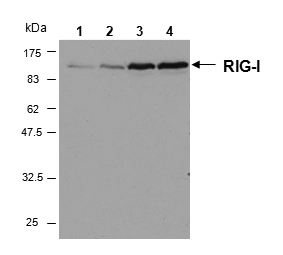anti-RIG-I mAb (Alme-1)
Product Code:
AG-20B-0009
AG-20B-0009
Host Type:
Mouse
Mouse
Antibody Isotype:
IgG1
IgG1
Antibody Clonality:
Monoclonal
Monoclonal
Antibody Clone:
Alme-1
Alme-1
Regulatory Status:
RUO
RUO
Target Species:
- Human
- Mouse
Applications:
- Immunohistochemistry (IHC)
- Immunoprecipitation (IP)
- Western Blot (WB)
Shipping:
Blue Ice
Blue Ice
Storage:
-20°C
-20°C
No additional charges, what you see is what you pay! *
| Code | Size | Price |
|---|
| AG-20B-0009-C100 | 100 ug | £380.00 |
Quantity:
Prices exclude any Taxes / VAT
Stay in control of your spending. These prices have no additional charges, not even shipping!
* Rare exceptions are clearly labelled (only 0.14% of items!).
* Rare exceptions are clearly labelled (only 0.14% of items!).
Multibuy discounts available! Contact us to find what you can save.
This product comes from: Switzerland.
Typical lead time: 7-10 working days.
Contact us for more accurate information.
Typical lead time: 7-10 working days.
Contact us for more accurate information.
- Further Information
- Documents
- References
- Show All
Further Information
Alternate Names/Synonyms:
RIG-1; Retinoic Acid-inducible Gene 1 Protein; DEAD-box Protein 58; Probable ATP-dependent RNA Helicase DDX58
Concentration:
1mg/ml
EClass:
32160000
Form (Short):
liquid
Formulation:
Liquid. In PBS containing 10% glycerol and 0.02% sodium azide.
Handling Advice:
After opening, prepare aliquots and store at -20°C.Avoid freeze/thaw cycles.
Immunogen:
Recombinant human RIG-I (aa 201-713).
Long Description:
Monoclonal Antibody. Recognizes human and mouse RIG-I. Isotype: Mouse IgG1. Clone: Alme-1. Applications: IHC, IP, WB. Liquid. In PBS containing 10% glycerol and 0.02% sodium azide. RIG-I and MDA5 are highly conserved helicases involved in the innate immune response to virus. RIG-I is a member of the DEAD-box RNA helicases and is activated by cytoplasmic dsRNA and 5?-ppp RNA produced during the viral replication. The protein is characterized by a N-terminal region with two caspase recruitment domains (CARD) and a C-terminal region harboring potential ATP-dependent RNA helicase activity. RIG-I recruits the CARD adaptor inducing IFN-beta (Cardif) in a CARD-CARD-dependent manner resulting in NF-kappaB and IRF3 activation.
NCBI, Uniprot Number:
O95786
Package Type:
Plastic Vial
Product Description:
RIG-I and MDA5 are highly conserved helicases involved in the innate immune response to virus. RIG-I is a member of the DEAD-box RNA helicases and is activated by cytoplasmic dsRNA and 5?-ppp RNA produced during the viral replication. The protein is characterized by a N-terminal region with two caspase recruitment domains (CARD) and a C-terminal region harboring potential ATP-dependent RNA helicase activity. RIG-I recruits the CARD adaptor inducing IFN-beta (Cardif) in a CARD-CARD-dependent manner resulting in NF-kappaB and IRF3 activation.
Purity:
>95% (SDS-PAGE)
Source / Host:
Purified from concentrated hybridoma tissue culture supernatant.
Specificity:
Recognizes human and mouse RIG-I.
Transportation:
Non-hazardous
UNSPSC Category:
Primary Antibodies
UNSPSC Number:
12352203
Use & Stability:
Stable for at least 1 year after receipt when stored at -20°C.
Documents
References
The antiviral adaptor proteins Cardif and Trif are processed and inactivated by caspases: M. Rebsamen, et al.; Cell Death Differ. 15, 1804 (2008) | Phosphorylation-mediated negative regulation of RIG-I antiviral activity: M.U. Gack, et al.; J. Virol. 84, 3220 (2010) | Incoming RNA Virus Nucleocapsids Containing a 5'-Triphosphorylated Genome Activate RIG-I and Antiviral Signaling: M. Weber, et al.; Cell Host Microbe 13, 336 (2013) | Lymphocytic choriomeningitis virus differentially affects the virus-induced type I interferon response and mitochondrial apoptosis mediated by RIG-I/MAVS: C. Pythoud, et al.; J. Virol. 89, 6240 (2015) | A phosphomimetic-based mechanism of dengue virus to antagonize innate immunity: Y.K. Chan & M.U. Gack; Nat. Immunol. 17, 523 (2016) | Sensing of latent EBV infection through exosomal transfer of 5'pppRNA: S.R. Baglio, et al.; PNAS 113, E587 (2016) | RNAs Containing Modified Nucleotides Fail To Trigger RIG-I Conformational Changes for Innate Immune Signaling: A. Fiegen Durbin, et al.; MBio 7, e00833 (2016) | Viral unmasking of cellular 5S rRNA pseudogene transcripts induces RIG-I-mediated immunity: J.J. Chiang, et al.; Nat. Immunol. 19, 53 (2018) | RIG-I recognizes the 5? region of dengue and zika virus genomes: M. Chazal, et al.; Cell Rep. 24, 320 (2018) | The Human Papillomavirus E6 Oncoprotein Targets USP15 and TRIM25 To Suppress RIG-I-Mediated Innate Immune Signaling: C. Chiang, et al.; J. Virol. 92, e01737-17 (2018) [KO Validation] | Zika virus NS3 mimics a cellular 14-3-3-binding motif to antagonize RIG-I- and MDA5-mediated innate immunity: W. Riedl, et al.; Cell Host Microbe 26, 493 (2019) | Influenza A virus M2 protein triggers mitochondrial DNA-mediated antiviral immune responses: M. Moriyama, et al.; Nat. Comm. 10, 6424 (2019) | Attenuation of the Innate Immune Response against Viral Infection Due to ZNF598-Promoted Binding of FAT10 to RIG-I: G. Wang, et al.; Cell Rep. 28, 1961 (2019) | ISG15-dependent activation of the sensor MDA5 is antagonized by the SARS-CoV-2 papain-like protease to evade host innate immunity: GQ. Liu, et al.; Nat. Microbiol. 6, 465 (2021) | NSs of the mildly virulent sandfly fever Sicilian virus is unable to inhibit interferon signaling and upregulation of interferon-stimulated genes: J.D. Wuerth & F. Weber; J. Gen. Virol. 102, (2021)



